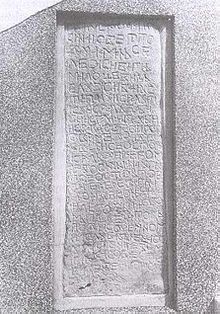Kočerin tablet

The Kočerin Tablet is a medieval tablet with an inscription written in Bosnian Cyrillic, in an archaic West Stokavian dialect of Serbo-Croatian, using Ikavian pronunciation.[1]
History and discovery
[edit]The stećak tombstone, which is placed on the grave of Viganj Milošević, was cut and inscribed in 1404 or 1405.[2] The text is positioned on the bottom of the stećak, which is discovered in a necropolis Lipovac, in a field just west and outside of today’s village of Kočerin, 9 kilometres (5.6 mi) away from the town of Široki Brijeg, Bosnia and Herzegovina, where it was discovered in 1983.[2][3] In 1872, stećak was moved to Kočerin and built-in into the right side of the local parochial office wall. In May 2004, it was carefully removed from the office wall and exhibited in the parochial premises in Kočerin.[3]
Dimensions
[edit]The tablet measures 54 centimetres (21 in) across on the bottom, 49 centimetres (19 in) in the middle, and 50 centimetres (20 in) at the top. It measures 134 centimetres (53 in) in height. The top part is damaged.[3]
Text
[edit]The tablet contains 25 rows of script, with 9-15 characters on each line. There are 300 characters in total and represents the largest known text in Bosnian Cyrillic.[1][3]
The text displays a large number of ligatures.[2] It is written in a Shtokavian Ikavian dialect, without nasal vowels, in a single-yer script, with some apparent Glagolitic influence.[4] The form svetago shows influence from Church Slavonic, but the rest of the inscription is free of Church Slavonicisms in its morphology.[4]
The text mentions how Viganj Milošević served five rulers: Banus Stjepan, King Tvrtko, King Dabiša, Queen Gruba, and King Ostoja.[2] The inscription ends by saying: имолꙋвасьненаст ꙋпаитенамеѣсмь билькаковиесте виꙉетебитикако вьсмьѣ (transl. And I beg you do not step on me because I was as you are and you shall be as I am).
| Original text | Latin transliteration | Modernized Serbo-Croatian | English |
|---|---|---|---|
| ☩ ваимеѡцаи синаисветаго |
☩ va ime ōca i sina i svetago |
☩ U ime oca i sina i svetoga |
☩ In the name of the Father and the Son and the Holy |
References
[edit]- ^ a b Šimić, Marinka (2004). "Jezik i pismo Kočerinske ploče (The Language and Script of Table from Kočerin)". Vitko: časopis Matice hrvatske Široki Brijeg (in Croatian). III (4): 5. Retrieved 21 January 2021.
- ^ a b c d 2004. Šefik Bešlagić, Leksikon stećaka.
- ^ a b c d "Hrvatska pošta Mostar". Archived from the original on 2012-04-25. Retrieved 2011-11-17.
- ^ a b 2011. Mateo Žagar, review of Jezik srednjovjekovnih kamenih natpisa iz Hercegovine.
